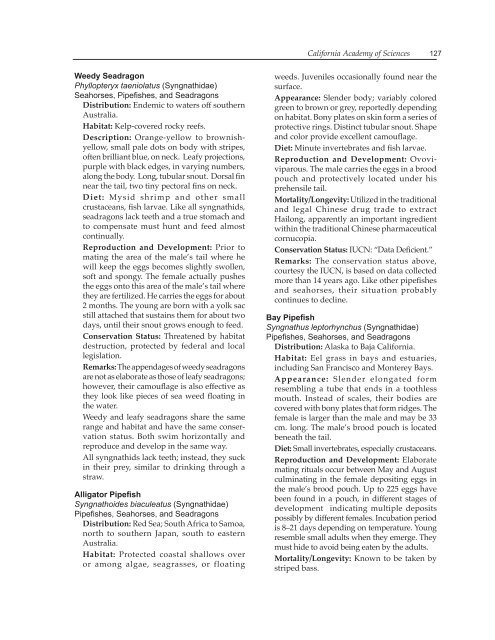THE STEINHART AQUARIUM - Gulf of Guinea Science ...
THE STEINHART AQUARIUM - Gulf of Guinea Science ...
THE STEINHART AQUARIUM - Gulf of Guinea Science ...
Create successful ePaper yourself
Turn your PDF publications into a flip-book with our unique Google optimized e-Paper software.
Weedy Seadragon<br />
Phyllopteryx taeniolatus (Syngnathidae)<br />
Seahorses, Pipefishes, and Seadragons<br />
Distribution: Endemic to waters <strong>of</strong>f southern<br />
Australia.<br />
Habitat: Kelp-covered rocky reefs.<br />
Description: Orange-yellow to brownishyellow,<br />
small pale dots on body with stripes,<br />
<strong>of</strong>ten brilliant blue, on neck. Leafy projections,<br />
purple with black edges, in varying numbers,<br />
along the body. Long, tubular snout. Dorsal fin<br />
near the tail, two tiny pectoral fins on neck.<br />
Diet: Mysid shrimp and other small<br />
crustaceans, fish larvae. Like all syngnathids,<br />
seadragons lack teeth and a true stomach and<br />
to compensate must hunt and feed almost<br />
continually.<br />
Reproduction and Development: Prior to<br />
mating the area <strong>of</strong> the male’s tail where he<br />
will keep the eggs becomes slightly swollen,<br />
s<strong>of</strong>t and spongy. The female actually pushes<br />
the eggs onto this area <strong>of</strong> the male’s tail where<br />
they are fertilized. He carries the eggs for about<br />
2 months. The young are born with a yolk sac<br />
still attached that sustains them for about two<br />
days, until their snout grows enough to feed.<br />
Conservation Status: Threatened by habitat<br />
destruction, protected by federal and local<br />
legislation.<br />
Remarks: The appendages <strong>of</strong> weedy seadragons<br />
are not as elaborate as those <strong>of</strong> leafy seadragons;<br />
however, their camouflage is also effective as<br />
they look like pieces <strong>of</strong> sea weed floating in<br />
the water.<br />
Weedy and leafy seadragons share the same<br />
range and habitat and have the same conservation<br />
status. Both swim horizontally and<br />
reproduce and develop in the same way.<br />
All syngnathids lack teeth; instead, they suck<br />
in their prey, similar to drinking through a<br />
straw.<br />
Alligator Pipefish<br />
Syngnathoides biaculeatus (Syngnathidae)<br />
Pipefishes, Seahorses, and Seadragons<br />
Distribution: Red Sea; South Africa to Samoa,<br />
north to southern Japan, south to eastern<br />
Australia.<br />
Habitat: Protected coastal shallows over<br />
or among algae, seagrasses, or floating<br />
California Academy <strong>of</strong> <strong>Science</strong>s<br />
127<br />
weeds. Juveniles occasionally found near the<br />
surface.<br />
Appearance: Slender body; variably colored<br />
green to brown or grey, reportedly depending<br />
on habitat. Bony plates on skin form a series <strong>of</strong><br />
protective rings. Distinct tubular snout. Shape<br />
and color provide excellent camouflage.<br />
Diet: Minute invertebrates and fish larvae.<br />
Reproduction and Development: Ovoviviparous.<br />
The male carries the eggs in a brood<br />
pouch and protectively located under his<br />
prehensile tail.<br />
Mortality/Longevity: Utilized in the traditional<br />
and legal Chinese drug trade to extract<br />
Hailong, apparently an important ingredient<br />
within the traditional Chinese pharmaceutical<br />
cornucopia.<br />
Conservation Status: IUCN: “Data Deficient.”<br />
Remarks: The conservation status above,<br />
courtesy the IUCN, is based on data collected<br />
more than 14 years ago. Like other pipefishes<br />
and seahorses, their situation probably<br />
continues to decline.<br />
Bay Pipefish<br />
Syngnathus leptorhynchus (Syngnathidae)<br />
Pipefishes, Seahorses, and Seadragons<br />
Distribution: Alaska to Baja California.<br />
Habitat: Eel grass in bays and estuaries,<br />
including San Francisco and Monterey Bays.<br />
Appearance: Slender elongated form<br />
resembling a tube that ends in a toothless<br />
mouth. Instead <strong>of</strong> scales, their bodies are<br />
covered with bony plates that form ridges. The<br />
female is larger than the male and may be 33<br />
cm. long. The male’s brood pouch is located<br />
beneath the tail.<br />
Diet: Small invertebrates, especially crustaceans.<br />
Reproduction and Development: Elaborate<br />
mating rituals occur between May and August<br />
culminating in the female depositing eggs in<br />
the male’s brood pouch. Up to 225 eggs have<br />
been found in a pouch, in different stages <strong>of</strong><br />
development indicating multiple deposits<br />
possibly by different females. Incubation period<br />
is 8–21 days depending on temperature. Young<br />
resemble small adults when they emerge. They<br />
must hide to avoid being eaten by the adults.<br />
Mortality/Longevity: Known to be taken by<br />
striped bass.


